by Winding Pathways | Jul 26, 2018 | (Sub)Urban Homesteading, Birds, Bugs, Flowers/Grasses, Garden/Yard, Nature, Reflections/Profiles, Wonderment
The Gazette in Cedar Rapids has had several interesting nature stories connected to creating wondrous yards. Living Section features “Birds do it, Bees do it”, “Add a Little Luck to Your Landscape” and Purslane (by Winding Pathways). We loved reading about the birds and bees’ cooling strategies and welcomed the return of clover to yards as natural nitrogen fixers and deep-rooted water retention plants. And, of course, we love to eat purslane. Let us know ways you fix this healthy vegetable.
Also an article on wasps of late summer. They are beneficial, ‘though deserve keeping distance.

Success on the Bena Farm!
Best of all was the picture of the Monarch Chrysalis from friends, Nancy and Gordon Bena found on their farm. Let’s keep encouraging habitat for insects that form the basis of life for many other creatures.
by Winding Pathways | Jul 19, 2018 | (Sub)Urban Homesteading, Amphibians/Reptiles, Birds, Garden/Yard, Mammals, Nature
Susan Hrobar
guest blogger
Fun Through the Window
We are fortunate to live at the end of a channel on a small lake. Our north facing windows face our backyard and the channel. One of our friends, who knows very little about nature, does not understand that after living here for 18 years, we still get excited when we see any wildlife in our yard and in the channel. Most of my photos are taken from windows inside the house, hoping to not spook my photo subjects. We frequently have deer coming through and we can tell which paths are being worn into the ground. During the winter we’ve taken photos of deer amidst the falling snowflakes. And, on our trail cam, we have “caught” coyotes, fox, raccoons, opossums, and neighborhood kitties.
Tom Turkey
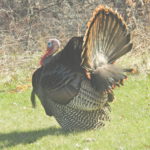
Strutting
This spring we have had a special bonus of occasionally watching a male turkey strut between our and the neighbors’ yards. Usually, he is skittish and if he spots me looking out a window, he quickly moves out of sight. One morning he must have felt like he was “king of the hill” and actually posed for photos about 20 feet from where I was watching him. I have also watched him fly over the channel near dusk and find a tree to roost in for the night. It always amazes me to watch these big birds fly through the trees, as normally you only see them walking and running on the ground.
Turtle Habitat

Lounging on a log
Last summer when the water level was high, an oak tree uprooted and fell into the channel, covering both sides of the channel, and completely blocking our water access to the main lake. Because the channel is narrow, there is little clear land on either side. The oak landed at the bottom of a steep hill, so removing it was quite a process. It took a bucket truck on top of the hill, a small boat in the channel, lots of ropes, and a very talented arborist to take care of the problem. This spring the water is lower and that downed tree is now a horizontal stump about four feet long partially submerged from where it fell.
The turtles love this new sunning perch! We have never seen so many turtles at one time. So far, our biggest count has been nine painted turtles on the log. In spring we sometimes get lucky to see a large soft-shell turtle swimming in the channel and climbing out onto the shore. The females are much larger than the males.
Wood Duck- Goose Dustoff
On a recent rainy day, we spotted a pair of wood ducks. They are also very skittish and do not like to pose for photos. We watched as they flew up into a large basswood tree and perched on the branch. I think that is the first time I have ever seen ducks sitting in the trees. It was not a great day for photos, but I tried anyway.
The ducks flew to another tree, rested for a while, and then flew down to the water. Mr. Wood Duck and Mr. (Canada) Goose then had an altercation on the grass with much hissing, honking, flapping of wings, and chasing.

Male wood duck
Mr. Wood Duck was very proud of himself for chasing the goose parents and two goslings of out “his” channel. Mrs. Wood Duck cheered him on while sitting on top of our boat motor. My husband, John, had the fun of watching the goose and duck stand-off. I was trying to get to a different window without all the raindrops obscuring my view. That did not work, but it made me smile to hear John laughing and enjoying the whole spectacle.
Loving Our Wildlife
Even after nearly two decades, we still so enjoy our yard and sharing our stories about animals and plants.
-

-
Night activity
-
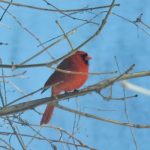
-
Male Cardinal in a tree.
-
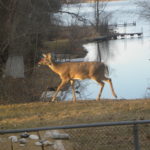
-
Deer in yard.
-

-
Swimming
-

-
A heron spreads its wings
-
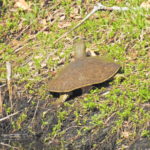
-
Female soft shells are larger than the male.
by Winding Pathways | Jul 8, 2018 | Birds, Garden/Yard, Garden/Yard, Nature
This Nectar is TOOOO Hot! Ahh, Just Right!
Lijun Chadima, Guest blogger
Every year I always like to put the hummingbird feeder out as soon as the weather warms up. It’s been difficult this spring because of the crazy temperature fluctuations. Earlier this spring I was enjoying the warm sunshine on our porch when a beautiful ruby-throated hummingbird flew over and seemed to be wondering, “Where the heck is the feeder?” I boiled the sugar water that afternoon and hung out the feeder the next morning.
Mystery – Why No Hummingbirds?
After a couple days the level of the sugar water in the feeder didn’t appear to go down at all. My little friend stopped by a couple more times, but each time he flew off after just a brief sip. I went out to
check the feeder and discovered it was so hot that I could barely hold it in my hand. No wonder the hummingbirds weren’t drinking any! I suddenly remembered a bird show I saw on PBS that stated hummingbirds try to avoid extreme heat, so that afternoon I took the feeder down from its regular spot which was in direct sunlight, and moved it to a new location where it was in the shade under the sun umbrella.
Mystery Solved!
That apparently did the trick because the very next day multiple hummingbirds took turns drinking from the feeder.
Hummingbirds are a source of endless fascination for me. They are full of energy and dart around the sky in all directions like little helicopters. What a treat when one actually stops to rest on the ledge and enjoy a drink from the feeder. Just remember to keep it in the shade so it’s not too hot for them!
Click on the link below, download and watch the video by Lijun of the hummingbird happily sipping nectar in the shade.
by Winding Pathways | Jul 5, 2018 | Garden/Yard

Hemp is amazingly tough and useful.
As we drove along a rural road recently we spotted a healthy patch of wild marijuana.
Most Iowans call it ditch weed. For an” illegal” plant it’s amazingly common across much of the United States and loves living in poor soil out in the hot summer sun.
The plant is technically called Cannabis sativa and comes in two forms that look identical. One is usually called marijuana and contains the active ingredient THC that gives it medicinal and psychoactive properties.
Ditch weed, or hemp, is the other form. It lacks much THC but can grow to 12 feet or even taller on sturdy stalks. It has many industrial uses such as strong rope, clothing, recyclable plastics and animal feed.
A thick patch of it even stopped the old truck we had once when it veered off the road with an approaching train. Phew! Dodged that disaster.
Cannabis was domesticated at least 12,000 years ago in South Central Asia, where it is also a native wild plant. People valued it so highly that they brought it along whenever they migrated to a new place. Uncommon in the United States until the early 1900s it was probably brought to our country by Mexican immigrants.
Cannabis was banned in 1937 by the Federal Marijuana Tax act that remains in force, even though several states have decriminalized it.
A fast-growing annual, cannabis may spring up in nearly anyone’s garden. Birds love the seeds, and patches are excellent habitat for pheasants and other wildlife.
Few plants are as controversial, but society is moving toward legalizing it for its many benefits. Read in The Gazette Natures’ Notes on some fascinating history of marijuana.
by Winding Pathways | Jun 7, 2018 | (Sub)Urban Homesteading, Birds, Garden/Yard, Nature
Birding in our Back Yard
We’ve traveled throughout the United States seeking interesting birds, and we just discovered the very best place.
It’s our backyard! Since we began actively diversifying the plants in our yard they’ve welcomed many new bird species to visit, rest, and eat. And, we live next to Faulke’s Heritage Woods, a 110 acres of shrubs and old trees that is a warbler and woodpecker haven.
Anyone who plants an array of bushes and grasses in their yard, even if it’s a tiny yard, can enjoy birding at home. Planting appropriate shrubs, mainly native species is important because some shrubs like barberry are invasive and crowd out beneficial plants.
Because the yard is right out the door, it is an easy place to grab the binoculars and a glass of wine or cup of tea and sit quietly.
Here’s what we’ve seen or heard in our yard in the past two weeks:
The winter birds left quietly – juncos and siskins. And, on their heels arrived the migrants.
Resident and Migratory Birds
Warblers: Black-Throated Green, Tennessee, Blackpoll, Cerulean, Yellow, Yellow-Rumped, and Redstart
Woodpeckers: Pileated, Hairy, Downy, Red Bellied, Red Headed, and Flicker. Earlier in the year, we saw the telltale evidence of the elusive sapsucker – wells drilled horizontally in sap filled trees.
Others: Bluebird, Cowbird, White Crowned and White Throated Sparrow, Chipping Sparrow, House Sparrow, Starling, Turkey, Crows, Vulture, Cooper’s Hawk, Barred and Horned Owls, Eagles, Chickadee, Nuthatch, Brown Creeper, House Wren, Titmouse, Goldfinch, House Finch, Robin, Wild Turkey, Hummingbird, Oriole, Rose-breasted Grosbeak, Indigo Bunting and a Wood Duck winging overhead. Additionally, Canada geese and pelicans have flown over on their way to ponds and lakes.
Recently Rich and a friend hiked to Hanging Rock in Effigy Mounds National Monument in northeast Iowa. They birded on the seven-mile walk. It was outstanding and spotted many species. But, not as many as we’ve seen sitting in our own backyard!
Winding Pathways encourages people to diversify the plants in their yards to create truly wondrous places that birds love. It can be the best place in the world to enjoy them.
-
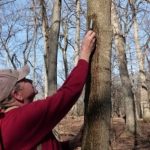
-
Rich points to horizontal holes of sapsucker.
-

-
Winging Overhead.
-

-
Getting nectar.
-

-
Two eagles in sky
-

-
A camouflaged creeper on tree trunk.
-
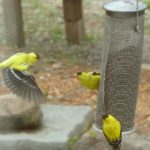
-
Iowa’s state bird
-

-
The cheerful denizens of open woods.
-

-
Checking out a birdhouse
-

-
Male bluebird.
-

-
On a branch
by Winding Pathways | May 31, 2018 | (Sub)Urban Homesteading, Garden/Yard, Garden/Yard
Problem with Hot Weather
A friend emailed today with this dilemma: “I got a whiff of a horrible smell near my rain barrel. I looked inside, and there’s a horrible, putrid layer of something floating on the top of the water. I think it might have come from all the fuzz from the trees in the past few days. Do you think I should empty the barrel, scrub it out, and start over? I do have that screen over the top, but something obviously got through it and seems to be “growing” on top of the water.”
Answer
YES!
Solution

Keep your rain barrels clean in hot weather with these easy tips.
It’s important to do these three things to keep the water fresh:
1. Clean gutters to keep leaves, catkins, and other stuff from getting into the barrel and clean the screen at the top of the barrel.
2. Use the water. Don’t let it stand in the barrel for too long. If it’s really rainy water moves through the barrels and helps keep it fairly fresh.
3. A couple of times during the summer empty the barrel, take the lid off, and wash it out with tap water.
4. Winding Pathways has cleaned the screens on our rain barrels several times already and after each rainstorm. They tend to plug up most during the first few rainstorms. It might also help to put a very small amount of chlorine bleach in the water. It’s toxic to bacteria and molds that might live in the barrel.
A little practical maintenance will make using rain barrels a pleasure and help your plants.






















